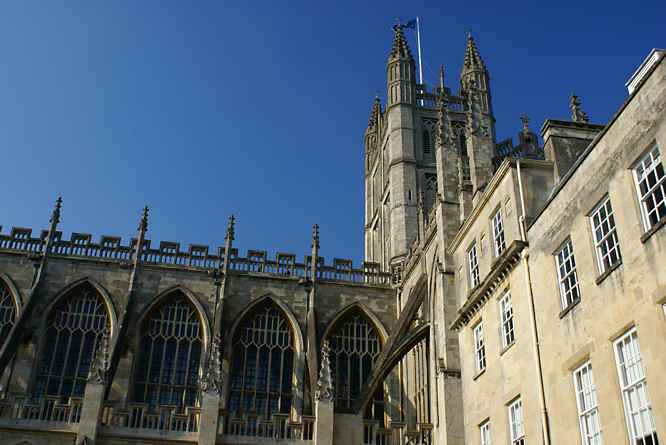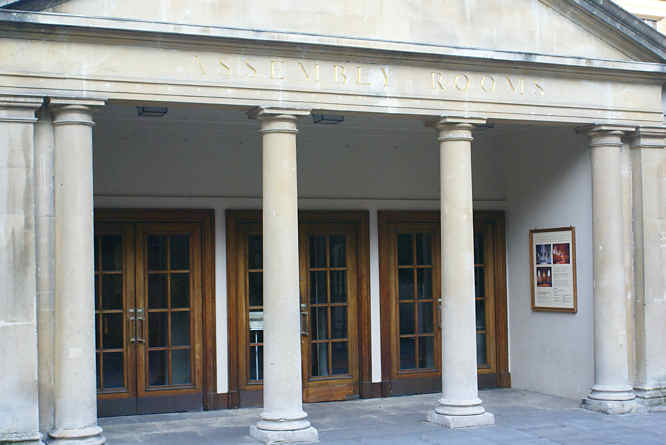Bath Abbey
Bath Abbey is tucked in among the shops and houses of the city centre. You suddenly come across it when you turn a corner. There has been a church on this site since just before 800AD. The Anglo Saxon church was pulled down by the Normans.

They built a Cathedral but that was allowed to fall into ruins as it was too large for the monastery it served. The Cathedral was demolished and the Abbey was founded in 1499 in it's place. Henry VIII ordered it ruined during the dissolution of the monasteries in 1539 but it was rebuilt and finally completed in 1611.
There is officially no charge to visit inside the Abbey but there is a 'suggested donation' which goes towards the extensive costs of maintaining the building. Inside there are some impressive stained glass windows and an elegant fan vaulted ceiling.
The Abbey's tower is open every day (except Sunday) as part of a tour. It offers panoramic views of the city but you have to climb 212 steps to the top of the tower. These tours run every hour. At night the Abbey is illuminated beautifully. Look for the rear terrace, descend the stairs, and visit the Bath Abbey history Heritage Vaults.

The City of Bath Assembly Rooms
For over two hundred years, the Assembly Rooms was the evening social centre of Bath. In Georgian and Victorian times the elite of high society would visit the Assembly Rooms to dance at Balls, drink tea, play cards, talk with friends, flirt, arrange marriages, eat and listen to music. It was the in thing to do. This is where people went to see others and be seen. It has a striking neo-classical exterior and interior that was opened in 1771.
There are four rooms, the ball room, the Octagon room, the card room and the tea room also known as the concert room. Balls were held in the Ball room twice a week and attracted between 800 to 1,200 people. Notice that the windows in the ball room are set above head height. This was to stop the lower classes looking in.
The ceilings are high to provide good ventilation and a place for the smoke to go. The Tea Room was used for music concerts as well as eating and drinking. Part of the cost of the Ball room ticket in the old days included refreshments. There was normally a break in the proceedings. The Octagon Room linked the Tea Room and the Ballroom. It was used as a room where cards were played and music played. Because more space was needed the Card room was added in 1777.
It is used as a location for many period costume drama films and TV shows. You will find the Assembly Rooms to the north of the old city centre. The building is owned by the National Trust and leased to Bath City Council. It is open daily from 11am to 5pm and is free. Both Charles Dickens and Jane Austin mentioned the Assembly Rooms in their novels. Johann Strauss the Elder, Joseph Haydn and Franz Liszt played at the Assembly Rooms.
Jane Austin wrote in her novel Northanger Abbey 'Mrs Allen was so long in dressing, that they did not enter the ball-room till late. The season was full, the room crowded, and the two ladies squeezed in as well as they could. As for Mr Allen, he repaired directly to the card-room, and left them to enjoy a mob by themselves.' Jane Austin visited Bath as a young girl and later lived at several addresses in bath. She attended Balls in the Assembly Rooms.
Charles Dickens visited the Assembly rooms a number of times and also gave readings of his works. In his novel The Pickwick Papers he wrote, 'In the ball-room, the long card-room, the octagonal card-room, the staircases, and the passages, the hum of many voices, and the sound of many feet, were perfectly bewildering. Dresses rustled, feathers waved, lights shone, and jewels sparkled. There was the music - not of the quadrille band, for it had not yet commenced; but the music of soft tiny footsteps, with now and then a clear merry laugh - low and gentle, but very pleasant to hear in a female voice, whether in Bath or elsewhere'.
Book your accommodation in Bath with Amazon.co.uk Destinations

Click here to find accommodation in Bath